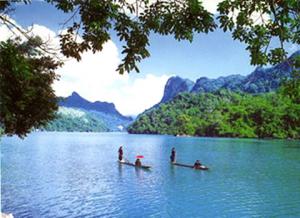Ba Be Lake becomes Vietnam’s third Ramsar site

The Ministry of Natural Resources and Environment will present the UNESCO’s decision recognizing Ba Be Lake as a Ramsar site (wetland of international importance” to the Ba Be Lake management board on June 5, the World Day for Environment.
Earlier, The Secretary General of Ramsar Convention, Anad Tiega signed the decision that recognizes Vietnam’s Ba Be Lake as the wetland of international importance. This is the third Ramsar site in Vietnam, besides Xuan Thuy (Nam Dinh province) and Bau Sau (Dong Nai province).
Having been formed approximately 200 million years ago, the 10,048ha Ba Be Lake is located at the elevation of 178m above sea level, in Nam Mau commune, Bac Kan district, Bac Kan province, in the northeastern region. It is the largest natural lake in Vietnam. It is surrounded by limestone cliffs, which in turn are covered by primary forests. This is the only natural lake on amountain and the largest natural lake in Vietnam.
Ba Be Lake is a featured geographical science and is a biodiversity reservoir. It is a part of the Ba Be National Park.
In 1995, Ba Be Lake was recognized as one of the 20 special fresh-water lakes in the world that need protection. In 2004, the Ba Be National Park was recognized as the heritage park of the Association of Southeast Asian Nations (ASEAN).
The Ramsar Convention (The Convention on Wetlands of International Importance, especially as Waterfowl Habitat) is an international treaty for the conservation and sustainable utilization of wetlands. It is named after the town of Ramsar in Iran.
In September 1988, the Ramsar Convention Office recognized Xuan Thuy as Vietnam’s first Ramsar site. Vietnam is the first country in Southeast Asia joining Ramsar Convention.
In August 2005, Bau Sau, which is located inside the Cat Tien National Park in the southern province of Dong Nai was recognized as Vietnam’s second Ramsar site.
The Agency for Biodiversity Preservation said that Vietnam would nominate Tram Chim as the fourth Ramsar site of Vietnam.









